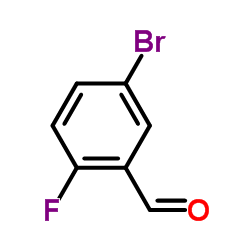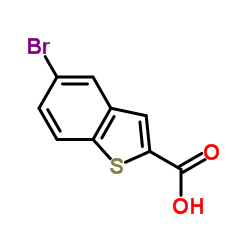7312-11-0
| Name | methyl 5-bromo-1-benzothiophene-2-carboxylate |
|---|---|
| Synonyms |
5-Bromobenzo[b]thiophene-2-carboxylic acid methyl ester
Methyl 5-bromo-1-benzothiophene-2-carboxylate T56 BSJ CVO1 GE methyl 5-bromobenzo[b]thiophen-2-carboxylate Benzo[b]thiophene-2-carboxylic acid, 5-bromo-, methyl ester Benzo[b]thiophene-2-carboxylic acid,5-bromo-,methyl ester 5-bromo-benzo[b]thiophen-2-carboxylic acid methyl ester 5-Bromo-benzo[b]thiophene-2-carboxylic methyl ester methyl 5-bromo-benzo[b]thiophene-2-carboxylate 5-bromo-1-benzothiophene-2-carboxylic acid methyl ester 5-Bromo-benzo[b]thiophene-2-carboxylic acid methyl ester |
| Density | 1.6±0.1 g/cm3 |
|---|---|
| Boiling Point | 358.9±22.0 °C at 760 mmHg |
| Melting Point | 110ºC |
| Molecular Formula | C10H7BrO2S |
| Molecular Weight | 271.130 |
| Flash Point | 170.8±22.3 °C |
| Exact Mass | 269.934998 |
| PSA | 54.54000 |
| LogP | 5.05 |
| Vapour Pressure | 0.0±0.8 mmHg at 25°C |
| Index of Refraction | 1.663 |
Synonym:5-Bromo-benzothiophene-2-carboxylic acid Section 2 - COMPOSITION, INFORMATION ON INGREDIENTS
Risk Phrases: 20/21/22 36/37/38 Section 3 - HAZARDS IDENTIFICATION EMERGENCY OVERVIEW
Harmful by inhalation, in contact with skin and if swallowed. Irritating to eyes, respiratory system and skin. Potential Health Effects Eye: Causes eye irritation. May cause chemical conjunctivitis. Skin: Causes skin irritation. Harmful if absorbed through the skin. Ingestion: Harmful if swallowed. May cause irritation of the digestive tract. Inhalation: Harmful if inhaled. Causes respiratory tract irritation. Chronic: No information found. Section 4 - FIRST AID MEASURES Eyes: Immediately flush eyes with plenty of water for at least 15 minutes, occasionally lifting the upper and lower eyelids. Get medical aid. Skin: Get medical aid. Flush skin with plenty of water for at least 15 minutes while removing contaminated clothing and shoes. Wash clothing before reuse. Ingestion: Never give anything by mouth to an unconscious person. Get medical aid. Do NOT induce vomiting. If conscious and alert, rinse mouth and drink 2-4 cupfuls of milk or water. Wash mouth out with water. Inhalation: Remove from exposure and move to fresh air immediately. If not breathing, give artificial respiration. If breathing is difficult, give oxygen. Get medical aid. Notes to Physician: Treat symptomatically and supportively. Section 5 - FIRE FIGHTING MEASURES General Information: As in any fire, wear a self-contained breathing apparatus in pressure-demand, MSHA/NIOSH (approved or equivalent), and full protective gear. During a fire, irritating and highly toxic gases may be generated by thermal decomposition or combustion. Dangerous fire hazard in the form of dust when exposed to heat or flame. Extinguishing Media: Use water spray, dry chemical, carbon dioxide, or chemical foam. Section 6 - ACCIDENTAL RELEASE MEASURES General Information: Use proper personal protective equipment as indicated in Section 8. Spills/Leaks: Vacuum or sweep up material and place into a suitable disposal container. Clean up spills immediately, observing precautions in the Protective Equipment section. Avoid generating dusty conditions. Provide ventilation. Section 7 - HANDLING and STORAGE Handling: Minimize dust generation and accumulation. Avoid breathing dust, vapor, mist, or gas. Avoid contact with eyes, skin, and clothing. Keep container tightly closed. Avoid ingestion and inhalation. Use with adequate ventilation. Wash clothing before reuse. Storage: Store in a cool, dry place. Store in a tightly closed container. Section 8 - EXPOSURE CONTROLS, PERSONAL PROTECTION Engineering Controls: Facilities storing or utilizing this material should be equipped with an eyewash facility and a safety shower. Use adequate ventilation to keep airborne concentrations low. Exposure Limits CAS# 7312-11-0: Personal Protective Equipment Eyes: Wear appropriate protective eyeglasses or chemical safety goggles as described by OSHA's eye and face protection regulations in 29 CFR 1910.133 or European Standard EN166. Skin: Wear appropriate protective gloves to prevent skin exposure. Clothing: Wear appropriate protective clothing to prevent skin exposure. Respirators: Follow the OSHA respirator regulations found in 29 CFR 1910.134 or European Standard EN 149. Use a NIOSH/MSHA or European Standard EN 149 approved respirator if exposure limits are exceeded or if irritation or other symptoms are experienced. Section 9 - PHYSICAL AND CHEMICAL PROPERTIES Physical State: Powder Color: brown Odor: mild odor pH: Not available. Vapor Pressure: Not available. Viscosity: Not available. Boiling Point: Not available. Freezing/Melting Point: 113 deg C Autoignition Temperature: Not available. Flash Point: Not available. Explosion Limits, lower: Not available. Explosion Limits, upper: Not available. Decomposition Temperature: Solubility in water: Specific Gravity/Density: Molecular Formula: C10H7O2SBr Molecular Weight: 270.11 Section 10 - STABILITY AND REACTIVITY Chemical Stability: Stable under normal temperatures and pressures. Conditions to Avoid: High temperatures, dust generation, prolonged exposure to air, direct sunlight.. Incompatibilities with Other Materials: Strong oxidizing agents, bases. Hazardous Decomposition Products: Carbon monoxide, carbon dioxide, hydrogen bromide, sulfur oxides (SOx), including sulfur oxide and sulfur dioxide, bromine. Hazardous Polymerization: Will not occur. Section 11 - TOXICOLOGICAL INFORMATION RTECS#: CAS# 7312-11-0 unlisted. LD50/LC50: Not available. Carcinogenicity: Methyl 5-bromo-1-benzothiophene-2-carboxylate - Not listed by ACGIH, IARC, or NTP. Section 12 - ECOLOGICAL INFORMATION Section 13 - DISPOSAL CONSIDERATIONS Dispose of in a manner consistent with federal, state, and local regulations. Section 14 - TRANSPORT INFORMATION IATA Shipping Name: Not regulated. Hazard Class: UN Number: Packing Group: IMO Shipping Name: Not regulated. Hazard Class: UN Number: Packing Group: RID/ADR Shipping Name: Not regulated. Hazard Class: UN Number: Packing group: Section 15 - REGULATORY INFORMATION European/International Regulations European Labeling in Accordance with EC Directives Hazard Symbols: XN Risk Phrases: R 20/21/22 Harmful by inhalation, in contact with skin and if swallowed. R 36/37/38 Irritating to eyes, respiratory system and skin. Safety Phrases: S 22 Do not breathe dust. S 26 In case of contact with eyes, rinse immediately with plenty of water and seek medical advice. WGK (Water Danger/Protection) CAS# 7312-11-0: No information available. Canada None of the chemicals in this product are listed on the DSL/NDSL list. CAS# 7312-11-0 is not listed on Canada's Ingredient Disclosure List. US FEDERAL TSCA CAS# 7312-11-0 is not listed on the TSCA inventory. It is for research and development use only. SECTION 16 - ADDITIONAL INFORMATION N/A |
| Hazard Codes | Xi |
|---|---|
| HS Code | 2934999090 |
|
~71% 
7312-11-0 |
| Literature: BAYER HEALTHCARE AG Patent: WO2003/104227 A1, 2003 ; Location in patent: Page 51 ; |
| Precursor 2 | |
|---|---|
| DownStream 2 | |
| HS Code | 2934999090 |
|---|---|
| Summary | 2934999090. other heterocyclic compounds. VAT:17.0%. Tax rebate rate:13.0%. . MFN tariff:6.5%. General tariff:20.0% |



